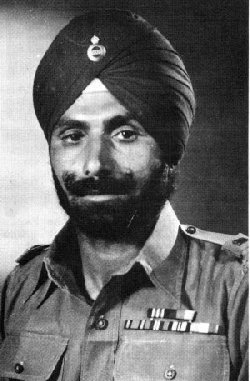Lance Naik Karham Singh (P.V.C.)
Karham Singh was born on 15 September 1915 at Sehna village in Sangrur District of Punjab in the house of Sardar Uttam Singh. Belonging to the downtrodden of the society and owing to financial difficulties, he enlisted into the Army as number 22356 of First Sikh regiment as Sepoy on 15 September 1941.
He faced the Japanese at Burma Front in 1945. Fighting in the deep jungles of Burma against the formidable force of Japanese he won the highest award for bravery by British.
Lance Naik Karham Singh is the only Indian to win highest medals of both British and Indian government. He won the British highest gallantry award in Second World War Burma Campaign. He got a promotion and was made Lance Naik.
On 15th August 1947 India gained its independence from British and thus Army was now transferred under Government of India. In january of 1948, Pakistan army launched offensive against the state of Kashmir, which was independent at that time. At the last moment Hari Singh, the Maharaja of Kashmir, joined the Indian union and thus Kashmir became part of India and its defense the Indian Army's duty.
Sikh regiment was airlifted to Srinagar and asked to defend Kashmir against the offensive attack of the enemy. Few kilometers away from Srinagar, town of Tithwal was captured by Sikh Regiment. Defences against onslaught were prepared all around the city. Lance Naik Karam Singh and his men were posted in one post, outside Tithwal.
The enemy made numerous attempts to recapture Richhmar Gali and thence Tithwal. On 13 October 1948, coinciding with Id, the enemy decided to launch a brigade attack to retake Richhmar Gali and bypassing Tithwal advance into the Srinagar Valley. L/Nk Karam Singh was commanding a section. The enemy commenced his attack with heavy shelling of guns and mortars. The fire was so accurate that not a single bunker in the platoon locality was left unscathed. Communications trenches caved in.
Bravely, L/Nk Karam Singh went from bunker to bunker, tending the wounded and urging the men to fight. The enemy launched eight separate attacks that day. In one such attack, the enemy managed to obtain a foothold in the platoon's locality. Immediately L/Nk Karam Singh, who was severely wounded by then, with a few men, hurled himself in a counter-attack and evicted the enemy after a close quarter encounter which accounted for many enemy dead, having been dispatched by the bayonet. L/Nk Karam Singh proved himself to be a dauntless and born leader of men in crisis. Nothing could subdue him and no amount of fire or hardship could break his Khalsa spirit. His gallant actions on that day inspired his colleagues to face the massive onslaught unflinchingly. It was his fiercely proud spirit which was largely responsible for the gallant stand at Tithwal that day.
Sardar means leader. Any person with ability to lead that excels in time of crisis shows its "nerves of steel". Lance Naik Karham Singh retired from the Army as Subedar and honorary captain. Salute to Khalsa Warrior Karham Singh.
The Paramvir Chakra, which was awarded to Lance Naik Karham Singh is the highest medal for gallantry of the Indian Military. Since 1947, Indian defense forces have participated in various campaigns all around India and the world. India fought three wars with Pakistan in 1948, 1965 and in 1971 and one war with china in 1962.

